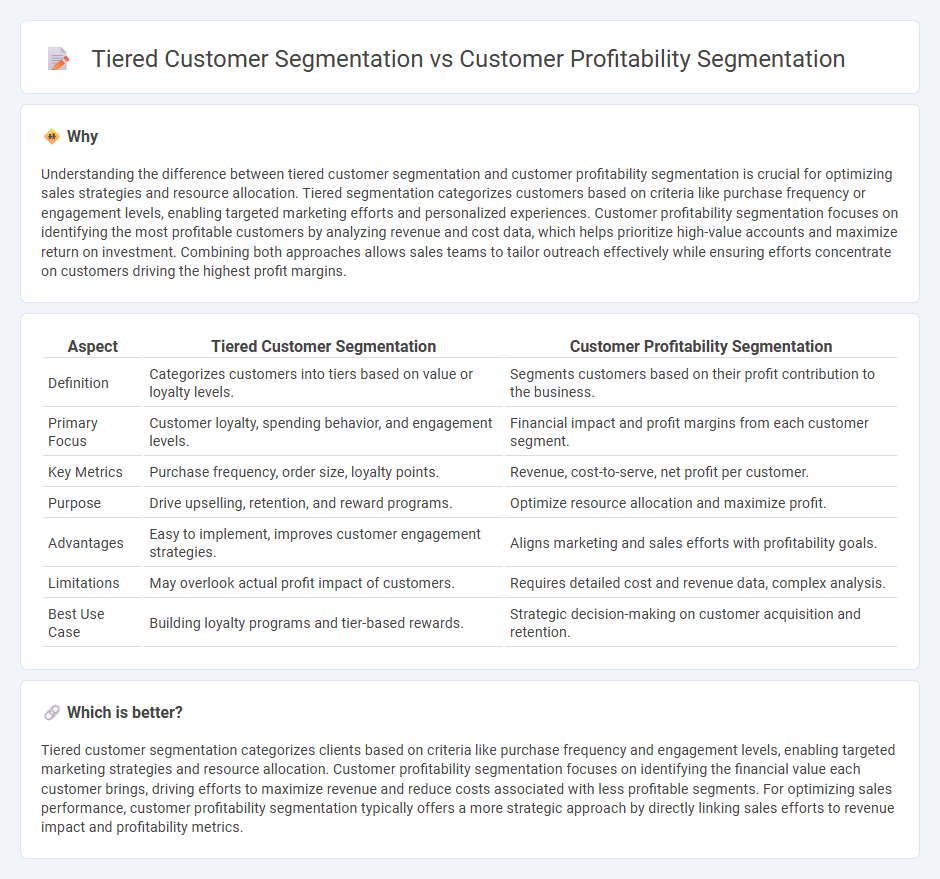
Tiered customer segmentation categorizes clients based on predefined levels such as revenue or purchasing frequency, enabling tailored marketing strategies and resource allocation. Customer profitability segmentation focuses on identifying segments according to profit margins generated, helping businesses prioritize high-value customers and optimize sales efforts. Discover how combining these approaches can maximize sales performance and customer retention.
Why it is important
Understanding the difference between tiered customer segmentation and customer profitability segmentation is crucial for optimizing sales strategies and resource allocation. Tiered segmentation categorizes customers based on criteria like purchase frequency or engagement levels, enabling targeted marketing efforts and personalized experiences. Customer profitability segmentation focuses on identifying the most profitable customers by analyzing revenue and cost data, which helps prioritize high-value accounts and maximize return on investment. Combining both approaches allows sales teams to tailor outreach effectively while ensuring efforts concentrate on customers driving the highest profit margins.
Comparison Table
| Aspect | Tiered Customer Segmentation | Customer Profitability Segmentation |
|---|---|---|
| Definition | Categorizes customers into tiers based on value or loyalty levels. | Segments customers based on their profit contribution to the business. |
| Primary Focus | Customer loyalty, spending behavior, and engagement levels. | Financial impact and profit margins from each customer segment. |
| Key Metrics | Purchase frequency, order size, loyalty points. | Revenue, cost-to-serve, net profit per customer. |
| Purpose | Drive upselling, retention, and reward programs. | Optimize resource allocation and maximize profit. |
| Advantages | Easy to implement, improves customer engagement strategies. | Aligns marketing and sales efforts with profitability goals. |
| Limitations | May overlook actual profit impact of customers. | Requires detailed cost and revenue data, complex analysis. |
| Best Use Case | Building loyalty programs and tier-based rewards. | Strategic decision-making on customer acquisition and retention. |
Which is better?
Tiered customer segmentation categorizes clients based on criteria like purchase frequency and engagement levels, enabling targeted marketing strategies and resource allocation. Customer profitability segmentation focuses on identifying the financial value each customer brings, driving efforts to maximize revenue and reduce costs associated with less profitable segments. For optimizing sales performance, customer profitability segmentation typically offers a more strategic approach by directly linking sales efforts to revenue impact and profitability metrics.
Connection
Tiered customer segmentation categorizes customers based on their value or engagement levels, enabling tailored sales strategies for each segment. Customer profitability segmentation focuses on the financial contribution of each customer, identifying which segments generate the highest margins. Together, these approaches optimize resource allocation and maximize overall sales performance by targeting the most lucrative customer tiers.
Key Terms
**Customer Profitability Segmentation:**
Customer profitability segmentation categorizes clients based on their actual or projected profit contribution, enabling businesses to allocate resources efficiently and tailor strategies to maximize financial returns. This approach relies on detailed financial metrics like revenue, costs, and margins associated with each customer, offering precise insights into which segments drive profitability. Explore how customer profitability segmentation can enhance strategic decision-making and optimize resource allocation.
Contribution Margin
Customer profitability segmentation prioritizes analyzing customer groups based on their direct contribution margin to identify high-value segments for targeted resource allocation. Tiered customer segmentation categorizes customers into levels based on overall value, including metrics like purchase volume and loyalty, but may overlook nuanced profitability distinctions captured by contribution margin analysis. Explore how integrating contribution margin-focused segmentation can enhance strategic decision-making in customer management.
Cost-to-Serve
Customer profitability segmentation analyzes revenue against Cost-to-Serve to identify high and low-value customers, enabling targeted resource allocation and margin improvement. Tiered customer segmentation groups customers based on predefined levels or tiers but may overlook nuanced cost differences affecting profitability. Explore how integrating Cost-to-Serve insights enhances segmentation strategies for optimized customer management.
Source and External Links
Segment Profitability Management: Realizing Sustained Growth - Customer profitability segmentation involves analyzing different customer groups to understand their buying habits and profitability to identify the most valuable segments and growth opportunities.
Segmenting Customers for Profit - The Strategic CFO(r) - Customer segments can be divided by characteristics like industry, geography, or sales volume and analyzed for profitability by breaking down sales and costs to identify profitable versus costly customer groups.
Customer Profitability Analysis Explained: Formula, Examples ... - Customer profitability analysis uses methods like RFM (recency, frequency, monetary) segmentation to categorize customers by profitability, helping businesses focus on the most valuable segments through data-driven insights.
 dowidth.com
dowidth.com